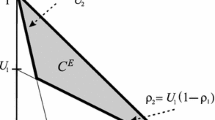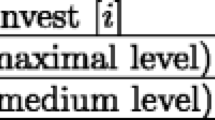Abstract
In this work we extend a result of Lehrer (Math Oper Res 17(1):175–199, 1992a) characterising the correlated equilibrium payoffs in undiscounted two player repeated games with partial monitoring to the case in which the signals are permitted to be stochastic. In particular, we develop appropriate versions of Lehrer’s concepts of “indistinguishable” and “more informative.” We also show that any individually rational payoff associated with a (correlated) distribution on pure action profiles in the stage game such that neither player can profitably deviate from one of his actions to another that is indistinguishable and more informative is the payoff of a correlated equilibrium of the infinitely repeated game.
Similar content being viewed by others
Notes
A version of this paper containing a somewhat more detailed version of the proof of Mertens et al. (2015) with some minor modifications to make clear that it does not depend on the assumption of nonstochastic signalling is available from the first author.
References
Abreu D, Pearce D, Stacchetti E (1986) Optimal cartel equilibria with imperfect monitoring. J Econ Theory 39:251–269
Abreu D, Pearce D, Stacchetti E (1990) Toward a theory of discounted repeated games with imperfect monitoring. Econometrica 58:1041–1063
Blackwell D (1951) Comparison of experiments. In: Proceedings of the second Berkeley symposium on mathematical statistics and probability. University of California Press, Berkeley and Los Angeles, pp 93–102
Blackwell D (1956) An analog of the minimax theorem for vector payoffs. Pac J Math 6:1–8
Forges F (1986) An approach to communication equilibria. Econometrica 54(6):1375–1385
Fudenberg D, Levine D (1991) An approximate folk theorem with imperfect information. J Econ Theory 54:26–47
Fudenberg D, Levine D, Maskin E (1994) The folk theorem with imperfect public information. Econometrica 62:533–554
Gossner O, Tomala T (2009) Repeated games with complete information. In: Meyers R (ed) Encyclopedia of complexity and systems science, vol LXXX. Springer, New York
Green EJ, Porter RH (1984) Noncooperative collusion under imperfect price information. Econometrica 52:975–994
Heller Y, Solan E, Tomala T (2012) Communication, correlation and cheap-talk in games with public information. Games Econ Behav 74:222–234
Kandori M (2002) Introduction to repeated games with private monitoring. J Econ Theory 102:1–15
Lehrer E (1989) Lower equilibrium payoffs in two-player repeated games with non-observable actions. Int J Game Theory 18:57–89
Lehrer E (1990) Nash equilibria of \(n\)-player repeated games with semi-standard information. Int J Game Theory 19:191–217
Lehrer E (1991) Internal correlation in repeated games. Int J Game Theory 19:431–456
Lehrer E (1992a) Correlated equilibria in two-player repeated games with nonobservable actions. Math Oper Res 17(1):175–199
Lehrer E (1992b) On the equilibrium payoff set of two-player repeated games with imperfect monitoring. Int J Game Theory 20:211–226
Lehrer E (1992c) Two-player repeated games with nonobservable actions and observable payoffs. Math Oper Res 17(1):200–224
Liu H (2014) Correlation and unmediated communication in repeated games with public information (unpublished)
Mailath GJ, Samuelson L (2006) Repeated games and reputations: long-run relationships. Oxford University Press, Oxford
Mertens J-F, Sorin S, Zamir S (2015) Repeated games. Cambridge University Press, Cambridge
Renault J, Tomala T (2004) Communication equilibrium payoffs in repeated games with imperfect monitoring. Games Econ Behav 49:313–344
Renault J, Tomala T (2011) General properties of long-run supergames. Dyn Games Appl 1:319–350
Solan E (2001) Characterization of correlated equilibria in stochastic games. Int J Game Theory 30:259–277
Sorin S (1990) Supergames. In: Ichiishi T, Neyman A, Tauman Y (eds) Game theory and its applications. Academic Press, San Diego, pp 46–63
Urbano A, Vila JE (2002) Computational complexity and communication: coordination in two player games. Econometrica 70:1893–1927
Urbano A, Vila JE (2004) Unmediated communication in repeated games with imperfect monitoring. Games Econ Behav 46:143–173
Author information
Authors and Affiliations
Corresponding author
Additional information
We are most grateful to the late Jean-François Mertens who initially suggested the question examined in this paper to Min Liu and who told us the ideas behind much of the analysis. We are also grateful to Abraham Neyman and Sylvain Sorin for comments during various stages of this work. The comments of two referees and an associate editor were also very helpful, particularly, but not exclusively, with regard to the literature since we originally wrote this paper. J. Hillas was privileged to be colleagues with Abraham Neyman for a good period of time at the beginning of his academic career. He was treated with great kindness by Abraham and learned a great deal from him, both about game theory and about what it meant to be an academic. He didn’t always take as much advantage of the opportunities that Abraham offered him as he should have. He is glad to humbly offer this paper to the special issue of the International Journal of Game Theory in honour of Abraham.
Appendix: The approachability theorem
Appendix: The approachability theorem
In this appendix we give some of the basic results concerning matrix games with vector payoffs. The results are due to Blackwell (1956) and our treatment follows (in a less general setting) that of Mertens et al. (2015).
As before we consider a finite stage game with pure action sets \(S^1\) and \(S^2\) and mixed action sets \(X^1\) and \(X^2\). Rather than having a payoff associated with each pair of actions we assume that there is a function \(\varphi \) from \(S=S^1 \times S^2\) to the set of probability distributions over some finite subset of \({\mathbb R}^k\). The game is played more or less as before. At each stage n player i chooses an action in \(S^i\) and then a point \(g_n\) is chosen at random according to \(\varphi (s^1_n,s^2_n)\). Both players then obtain some signal that reveals for player 1, at least, \(g_n\). We let \(\bar{g}_n = \frac{1}{n}\sum _{t=1}^n g_t\).
Definition 11
(Approachable) A set C in \({\mathbb R}^k\) is said to be approachable by player 1 if there is a strategy for player 1 in the infinitely repeated game for which \(d(\bar{g}_n,C)\) converges to zero almost surely.
Let \(f(s^1,s^2)\) be the expected value of \(\varphi (s^1,s^2)\) and for any \(x^1\) in \(X^1\) let \(Z(x^1)\) be the convex hull of the points in \(\{\sum _{s^1\in S^1} x^1(s^1)f(s^1,s^2) \mid s^2 \in S^2\}\).
Theorem 3
(The approachability theorem) Let C be any closed set in \({\mathbb R}^k\). Suppose that for any g not in C there is \(x^1\) \(({=}x^1(g))\) in \(X^1\) such that the hyperplane through h(g) a closest point in C to g perpendicular to the line segment between g and h(g) separates g from \(Z(x^1(g))\). Then C is approachable by player 1 using strategy \(\sigma ^1(\cdot ),\) a strategy depending on the history only through \(\bar{g}_n\) where
With that strategy,
and
where K is a bound on the second order moments of \(\varphi (s^1,s^2)\) for all \(s^1\) and \(s^2\).
We need, in fact, only one relatively simple implication of the approachability theorem.
Corollary 1
(Mertens et al. 2015, Corollary II.4.4) For any \(x^1\) in \(X^1\) the set \(Z(x^1)\) is approachable by player 1 using the constant strategy \(\sigma ^1(\cdot )=x^1.\) And, again, with this strategy inequalities (1) and (2) hold.
Rights and permissions
About this article
Cite this article
Hillas, J., Liu, M. Correlated equilibria of two person repeated games with random signals. Int J Game Theory 45, 137–153 (2016). https://doi.org/10.1007/s00182-015-0495-5
Accepted:
Published:
Issue Date:
DOI: https://doi.org/10.1007/s00182-015-0495-5




